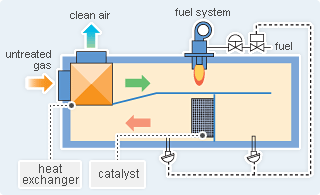Cataburn® (Catalytic Burning VOC Abatement System)
VOC Removal Technology | Post-Processing Units
What is VOC removal technology?
We offer a wide variety of environmental protection devices, covers from various exhaust gas treatment systems and dust collectors to wastewater treatment systems. This section introduces exhaust gas treatment system to dispose organic gases from various plants.
What is post-processing units?
- Energy-saving technology that stores and reuses combustion heat waste in combustion type detoxification treatment for hazardous substances.
- Technology that can offer optimal incineration detoxifying treatment method for hazardous substances according to the exhaust conditions and treatment goals.
- Want to prevent air pollution
- Want to reduce CO2 and enhance energy efficiency
Overview
Cataburn® has an especially great effect on the treatment of difficult-to-reuse mixed solvent gases and malodorous gases from painting, printing, chemical, electric wire, rubber, metal-casting, food, and livestock and fishery processing industries.
It can also be effectively used as post-treatment system to Admat®, a gas adsorptive enrichment system.
Features
-
Exhaust Treatment with High Treatment Efficiency and Reduced Secondary Contamination at Low Temperatures

 Sectional view of Cataburn®
Sectional view of Cataburn®
While direct combustion exhaust treatment system works at high temperatures from 700°C to 850°C, Cataburn®, which uses a catalyst for treatment, can operate at low temperatures from 250°C to 300°C.
It has a high margin regarding the SV value (exhaust gas volume/catalyst volume), and delivers high treatment efficiency with malodorus organic gas components even at low temperatures. It produces less NOx through high-temperature oxidation and consumes less fuel, resulting in smaller CO2 emissions. -
Doubled & redoubled energy saving
In addition to low treatment temperatures, a plate-type heat exchanger achieves the heat exchange between treated and untreated gases, delivering a greater energy saving impact. A higher exhaust gas temperature, as seen in the case of a dry kiln, results in less fuel costs, and a higher concentration of solvents further reduces energy consumption by enabling the solvent to be used as fuel.
-
Minimal running cost
When Cataburn is used for the exhaust gas from a dry kiln that has the HC concentration of 500ppm or higher on a xylene basis, untreated gas preheated with a heat exchanger goes into self-sustained combustion on the catalyst surface. This reduces running costs to a minimal level.
-
Safe & easy to operate
Cataburn® operates with a full-automatic control system. It features one-touch simple operation and requires no license or qualification.
Its safety system, including the combustion monitoring system, performs the pre-purge, post-purge, and gas volume control operations.
Adaptive Industrial Sector
| Adaptive Industry | Typical Target Substance |
|---|---|
| Paint factory | Toluene, xylene, IPA, methanol, MEK, and ester acetate |
| Printing factory | Toluene, IPA, MEK, hexane, and ester acetate |
| Chemical factory | Aldehydes, ketones, ethylene, carbon monoxide, and acrylic acid |
| Electric wire factory | Benzene, toluene, and ester acetate |
| Metal-casting factory | Phenol and formaldehyde |
| Food factory | Fatty acids and alcohols |
| Livestock and fishery processing industries | Fatty acids and mercaptans |
| Rubber processing industry | Toluene, isocyanates, and the smell of rubber |
